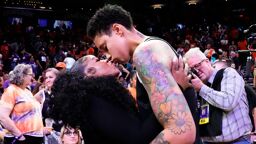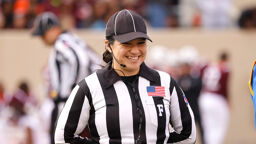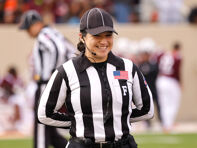Kyniska’s story is one of the great game-changes in sports history – and it has a strong lesbian twist to boot.
By Patricia Nell Warren
Outsports.com
The end of Women’s History Month is a good time for Outsports to celebrate the first female to wear a victor’s crown of olive leaves at the ancient Olympic Games. In 396 BCE, Kyniska, a king’s daughter from Sparta, won it in the prestigious tethrippon or four-horse chariot race.
“But women couldn’t compete in the ancient Olympics, “ some will say.
Oh, but they did. As owners, they could enter horses in the equestrian events… as long as a male charioteer was the public face on the entry. And the horse-owner was viewed as the winner, not the driver (who was usually a slave or hired professional).
 |
| Painting of a tethrippon, or four-horse chariot race. |
The story of how Kyniska masterminded her way to glory through this loophole in the Olympics rules is one of the great game-changes in sports history – and it has a strong lesbian twist to boot.
The ancient name for Kyniska’s homeland was Lakonia. One of the dozens of city-states that comprised Greece, it was no bigger than New Jersey — just a wide valley ringed by mountains and drained by a river, the Eurotas, that ran down to the Mediterranean. Outside its capital city, Sparta, were the fertile well-watered farmlands and a few mud-brick villages. The kingdom’s elite citizens numbered only perhaps 10,000 at its peak, supported by a larger population of freedmen and serfs (called helots).
Though tiny, Sparta stood out among Greeks for its unconventional ways. By channeling its citizens’ energies into a regimented, frugal, communal and clannish life, Sparta had clanked its bronze-armored way to being No. 1 military power in Greece.
But Sparta achieved this by easing some of the heavy patriarchal strictures on women that were traditional with other Greeks. To the Lakonians, a strong healthy active female was the ideal mother of soldiers, imbuing her sons with her own courage and toughness. So Spartan girls got the same rugged public-school education as boys. Scantily clad or even naked, they went out for the same sports as boys. To ensure that every child had a good support system, Spartan women could inherit and own property, and they enjoyed more sexual freedom than other Greek women.
Along with unconventional heterosexuality, the Spartans went a bit further than most Greeks on homosexuality as well — they institutionalized same-sex love, giving it a respectable place. From early teenhood, boys lived in separate communes where sexual intimacy was common. Older men and women might mentor young people of the same gender; mentoring could include an intimate relationship. Among the parthenoi, or young unmarried girls, lesbian passions found their voice in writings by the Spartan poet/educator Alcman.
In short, everything Lakonians did was culture shock for other Greeks. They saw Spartan women as “loose.”
Around 440 BC, Kyniska was born to King Archidamus II and his wife Eupolia. She had two brothers, and was to be a rich heiress from birth.
During her first years, Sparta was jarred by profound change. In 431, when Kyniska may have been nine, her royal father hurled Sparta into yet another war — the 30-year Peloponnesian War with Athens. The consequences were dire. Though Sparta technically won, its male population was drained by casualties. Women now outnumbered men, and moved to fill a void of economic influence.
Personal details about Kyniska are hard to find in the record. She may have been tall and blond, as many Spartans were. She may have been beautiful as well – Sparta wouldn’t have celebrated her later if she had been homely. Her compatriots idolized beauty in both genders. This may have tweaked sibling jealousy in her younger brother Agesilaos, who was recorded as short and lame.
Sparta’s sports complex for youth was located in a grove of sacred plane trees called the Platanitas. Nearby was the temple of virgin goddess Artemis Orthia, protectoress of the unmarried girls and boys who competed there. Kyniska was surely a familiar figure in the girls’ footraces on the dromos (track), or the naked wrestling in the gymnasium. For racing, Kyniska may have worn her long hair knotted up, a bit of gold jewelry, and the skimpy mini-skirt-length chiton that prompted other Greeks to refer to Spartan girl grumpily as “thigh flashers.”
But horse sport was tops with Kyniska. According to Sparta expert Sarah Pomeroy, her mother Eupolia’s family were a horsy clan. So Kyniska must have fallen in love with equines at an early age. Fine horses were life itself to the ancients — not only for war and daily use, but also for artistic and spiritual inspiration. The Spartans’ rich farmlands and grassy river bottoms gave them the resources to breed good horses, under the protection of Artemis Orthia, to whom these animals were sacred.
When Kyniska’s father died in 427 BCE, she may have been 13 years old. She divided her father's wealth with her two brothers, and must have inherited a big country estate with serfs and grooms. There – possibly under the watchful eye of her mother or her own mentor — the princess learned to ride astride and drive a cart and team. Pomeroy suggests that Kyniska might have been a tomboy.
Around age 18 or 20, Kyniska may have adopted the more austere look of an adult Lakonian woman – long chiton, short hair, no jewelry.
But there’s no evidence that she ever married or had children. Spartan royalty had strict rules about whom she could marry – but war casualties may have meant that there was no suitable match for her. On the other hand, she may have asserted a new kind of independence and refused to marry, spending her whole life among the parthenoi. She may have taken her turn at mentoring a girl by then.
The changing times had opened a door for Sparta’s royal and upper-class women. Though they never pushed as far as capturing the throne or seats in the Council of Elders, women now controlled much of the kingdom’s property, and expanded their influence in the arts and religion. With no family to occupy her, and no chance to rule the kingdom (that fell to her brothers Agis and Agesilaos), Kyniska looked for her own open door – one that would lead to excitement and achievement.
In the Mediterranean world, an olive crown at the Olympian Games made you a living demi-god in a way that we can't fathom today — even when we see the idolizing of modern winners like Michael Phelps. The difference: our sports are secular, while the traditional Greek games resonated with religion. Every four years, the often-quarreling Hellenic kingdoms declared a truce and gathered at Olympia’s sanctuary of Zeus to compete. As the ruling god among all Greek deities, Zeus was patron of the Games – and his will determined the victors.
The Spartans were obsessed with beating their old rival, Athens, at chariot racing. Prior to the Peloponnesian War, they’d been on a roll — winning seven out of eght tethrippons. But during the war, Sparta had been barred from the Games by their enemies. When Kyniska’s father died in 427, her older brother Agis became king and kept hammering at the war. Finally a truce was negotiated. The next opportunity for Sparta to compete would be the 96th Olympiad, in the year 396 on our calendar.
Race-crazy Spartans were thirsting for revenge.
By then, Kyniska had evidently noted that loophole in the Olympian rules. Then, as now, horse racing was a very costly sport. Up to that point, no Greek woman had ever commanded the resources that she had. Not only did Kyniska own a lot of land and human resources, but she had cash. With her family’s victory in the long war, new wealth had poured into Sparta, and she had a pile of foreign gold and silver to spend on horses.
So why not go for that first woman’s win? Why not in the most prestigious race of all – the tethrippon?
Greek historian Pausanias noted that Kyniska was "very ambitious" for this win. She may have taken her prayers to Artemis Orthia’s temple, leaving there a little lead votive figure of the goddess flanked by two horses.
But when King Agis died and her younger brother Agesilaos became king in 400, the ugly brother now butted heads with his pretty sister over racing. Agesilaos disapproved of the way that racing would burn up Spartan wealth. He was a reformist, looking to return his people to the good old days, when Spartans were less rich and self-indulgent.
“You should be breeding war horses, not racing horses,” he is said to have sniffed at her.
But Kyniska turned a deaf ear.
She probably started by finding a good trainer, and collecting the best bloodstock she could get. Libyans were the hot racing strain, ancestors of today’s Barb and Arabian horses – tough, refined animals with high-set tails and a fiery temperament. Through some noted horse broker, Kyniska may have found her stallions and mares in the Spartan colony of Cyrene in North Africa, famed as a source of winning chariot horses. Ships brought them to Lakonia’s seaport, Gytheio; from there, they marched the 25 miles to Sparta.
Next the princess had to wait a year for her foals to be born. Then she spent several years raising the young horses, having them trained to harness, galloping them in long workouts across the meadows to leg them up – perhaps even trying them out in local races. Only mature horses – five years old or more — could stand up to the stresses of the 8-mile tethrippon.
So Kyniska may have needed six or seven years, maybe more, to put together that perfect span of four horses. They had speed and athleticism and iron legs, plus the endurance and heart to gallop those 8 miles.
Most important, Kyniska had to find a top driver. If she lost the race, she'd never live it down. So she may have hired the best charioteer in the kingdom away from somebody else.
Today we can get a good idea of chariot racing’s atmosphere from the movie "Ben-Hur."
Historians concede that the film’s race details are pretty accurate. We see a dozen four-horse teams and chariots go careening around the hippodrome at breakneck speed, with awful pile-ups along the way that mangle men and horses alike. The ancients called them “shipwrecks.” Great ancient writers like Homer and Sophocles penned accounts of historic races that leap right off the page. It was such a colorful, thrilling, dangerous spectacle that, when Rome took up the sport, the Romans loved it even more than gladiator combats. Clearly the real-life event was even hairier and gorier than the movie.
As 396 neared and his sister’s team was looking good, Agesilaos evidently stopped grumping at her. He had figured out that a chariot win by a Spartan female would be the ultimate humiliation of Sparta’s old enemies. After all, they viewed Spartan women as whores. So the king started encouraging her ambition.
But money alone, or even good breeding and training, wouldn’t give them the win. They would also need a nod from Zeus. A stumble, a bronze harness buckle failing, could spell disaster.
When the summer of 396 came, Kyniska’s team and support crew set off for Olympia, some 200 miles away.
History doesn’t mention whether the princess went along — but I’m sure she must have. What wealthy and independent-spirited horse-breeder would sit at home at a time like this? Besides, her intention to enter would surely stir up hostility in other kingdoms – she must have feared for the safety of her horses and driver, and would have kept them under heavy guard.
Kyniska’s entourage arrived at Olympia a month early for the required selection process, as well as a chance to get the horses acclimatized. No doubt they were hosted and protected by some local ally in Olympia – perhaps the priestess of Demeter, who traditionally presided over the Games as a special guest. Her team may have done its last works at the Olympian hippodrome (racetrack), which was located just east of the temple of Zeus. This was where all the equestrian events took place. Next door was the stadium where other athletic contests occurred.
Day 1 of the Olympics was spent – as today — in ceremony, speeches, and hordes of athletes taking the Olympic oath, while spectators streamed in from all over.
As Day 2 dawned, the first morning would offer a program of various chariot races. Hundreds of teams and vehicles lined up at the great arched gateway. Then they filed into the hippodrome for a spectacular procession, while the owners’ names were loudly announced to Zeus. Thousands of spectators crowded the slopes flanking the track.
Kyniska’s super-fit horses were on their toes, knowing what was ahead. Their manes were neatly roached, their coats spotless. Their harness, the eight reins and the light modified war-chariot had been inspected over and over. The driver held his whip ready, wearing a headband and a long protective garment called the xystis, belted around the chest to keep it from flying up. This was the only Olympian event where men competed with clothes on. In case of a shipwreck, nobody wanted to be dragged naked in the dirt.
After the procession, the tethrippon was first on the program. As many as 60 chariots might have entered.
In the glare of morning sunlight, the great oval track awaited them, with a narrow median down the middle. Entries would run 12 laps around that 1,200-meter oval, with a sharp 180-degree turn around a pillar at each end. At one end was the long slanting row of starting gates, designed to release the outside teams first, since they had farther to run. The crowd was probably buzzing with outraged gossip — word had gotten around that a Spartan hussy was running a chariot.
We don't know if Kyniska was actually there to watch – Greek historians differed in their reports on whether women were allowed to view the Games or not. Worst case scenario — Kyniska had to wait it out somewhere else, biting her nails, perhaps at the villa where she was a guest. She might have been close enough to hear the crowd roar in the distance as the long line of starting gates jerked open.
That army of chariots poured out like a battle charge, raising a golden dust in the hot Mediterranean sun.
Kyniska would have worried about dirty tricks. The rules barred malicious interference, but every charioteer would have been under dire orders from his rich owner to not get beaten by that Lakonian chippy. So there were ways to wreck a rival that the judges might not see. An accident could destroy those wonderful animals into whom she had poured her heart's blood.
For strategy, Kyniska’s driver had the options that competitors have always used in long races. You could go out fast and stay in front, hoping your horses could hold the pace. Or you could sit towards the rear, and try to keep yourself out of trouble, hoping for a few shipwrecks to thin the field, so you could make a closing rush without much competition. Whatever your strategy, the sun would be in your eyes, blinding you through the dust, on the eastward leg of every lap.
The most dangerous moments were the 23 turns – as the team veered around the pillar, your chariot would go wildly loose like a racecar does. Its wheels would skid sideways, possibly hurling you out of the chariot by centrifugal force. Nobody used safety belts. If you cut the turn too close, you risked catching a wheel on the pillar and destroying your chariot. Result: you’d be tangled in the wreckage and dragged to death behind your runaway horses.
Kyniska must have died a thousand mental deaths by the time she heard the final rising roar in the distance. Somebody’s chariot was streaking past the finish at the judges’ podium. But whose?
Eventually a dusty messenger came galloping with the news, followed by her dusty, tired horses and driver going at a walk. The olive wreath was hers.
Four years later, to show the world that it was no fluke, Kyniska went back to Olympia for the 97th Games and won the tethrippon again.
The princess didn’t fail to thank the higher powers. Olympian Zeus had willed a woman’s victory – not once, but twice. It sent a strong message to the whole Mediterranean world. Traditionally the Olympic winners expressed their gratitude by dedicating a statue at Zeus’s sanctuary. These joined a vast collection of artworks and mementos that had accumulated for centuries. So Kyniska’s family ordered up a magnificent bronze statue of her chariot, horses and driver, one of the biggest ever given. They also dedicated a statue of Kyniska herself, made by the sculptor Apelleas, known for his sensitive works portraying women.
When historian Pausanias visited Olympia, he logged a mention of Kyniska’s bronzes and her boastful inscription, that ended:
I declare myself the only woman
in all Hellas to have won this crown.
Sadly, the names of the charioteer and horses didn’t get written down.
Kyniska’s win touched off a run of female victories. Next was Euryleonis, another Spartan who won the 2-horse race at Olympia in 368. In all, nearly a dozen women captured the crown, not only at Olympia, but also at other Greek games. When Kyniska died, Sparta declared her a national hero – one of the few women to be so honored in the kingdom’s history. A shrine was built for her cult at the sacred grove of plane trees, near the temple of Artemis Orthia.
A century and a half later, her win was still a target. Berenice II, the Macedonian queen of Ptolemy III of Egypt, fielded a team of brilliant Cyrene-bred mares that won a dozen races, including the Olympian tethrippon. In her victory inscription, Berenice bragged that she had stolen Kyniska's “ancient glory.”
As paganism dissolved into Christianity, this tradition of wealthy woman race-owners kept going. In Renaissance Italy, noble women ran horses in the palios. In Protestant England, the “virgin queen” Elizabeth I had her racing stable. Today Queen Elizabeth II is the world's most enduring royal lady winner and patron in horse racing. In the U.S., flat racing enjoyed the patronage and breeding achievements of socialite Elizabeth Arden, while in harness racing, Frances Dodge (of the Dodge auto royalty) played a similar role. Indeed, harness racing is today’s descendant – a tamer one — of chariot racing.
On a broader front today, women team owners emerge in other pro sports – from baseball’s Marge Schott, owner of the Cincinnati Reds, to Effa Manley, a pioneer in the old Negro Baseball League. The NFL has the Rams’ owner Georgia Frontiere and Denise DeBartolo York of the 49ers. In 2008, the WNBA approved the sale of Seattle Storm to an independent LLC owned by Lisa Brummel, Ginny Gilder, Anne Levinson, and Dawn Trudeau. Brummel, a Microsoft executive, is openly lesbian.
Meanwhile, Kyniska is still remembered today – her victory still a milestone in ancient and modern Olympic competition.
Archeology adds its own magic to her memory. Amid the ruins of Olympia, diggers actually found the battered marble base of Kyniska’s statue. Part of the inscription reported by Pausanias is still legible. Sad to say, the statue itself is missing, possibly destroyed by misogynist Christians who sacked the temple in the 5th century. If so, they cheated us of the chance to see the face of that remarkable sportswoman who lived 2,400 years ago.
This is another in a series on gays and lesbians in sports history by Patricia Nell Warren. Check out her archive.
Further reading:
Books:
"Spartan Women," by Sarah B. Pomeroy (Oxford University Press, 2002)
"Agesilaos and the Crisis of Sparta," by Paul Cartledge (Johns Hopkins University Press, 1987).
"Sport and Spectacle in the Ancient World," by Donald G. Kyle (Wiley-Blackwell, 2006)
"Brief History of the Olympic Games," by David C. Young (Blackwell Publishing Ltd., 2004)
Websites:
“Female Property Ownership and Status in Classical and Hellenistic Sparta,” by Stephen Hodkinson (Center for Hellenic Studies, Harvard University).
“The Only Woman in All Greece,” by Donald G. Kyle, Journal of Sport History, summer 2003.
“Cynisca of Sparta”
Lesbianism in the “Maiden Songs” of Alcman
“The House of Ptolemy,” by E.R. Bevan
The Libyan horse
Chariots of ancient Greece
Charioteers of ancient Greece
The Hippodrome Rediscovered at Olympia
Video clip of "Ben-Hur" chariot race
Copyright © 2009 by Patricia Nell Warren. All rights reserved.







































